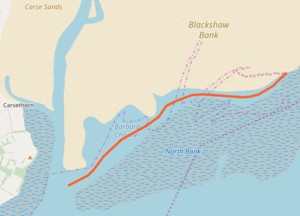Tag:waterway=tidal_channel
 |
| Description |
|---|
| A natural intertidal waterway in mangroves, salt marshes, and tidal flats with water flow in the direction of the tide. |
| Group: waterways |
| Used on these elements |
| Implies |
|
| Useful combination |
| See also |
| Status: approved |
| Tools for this tag |
|
Use waterway=tidal_channel for a natural tidal waterway within the coastal marine environment with bi-directional flow of salty water which depends on the tides. Such channels form along protected coasts with limited wave action and a gradual slope, usually within tidal mud flats, salt marshes or mangroves.
These channels can be distinguished from rivers due to the higher salinity levels and because the flow of water away from the sea at high tide is equal to the flow of water towards the sea at low tide.
These features are also know as a tidal creek, pill, or tidal inlet.
Tidal channels vs river estuaries
Tidal channels are frequently found along coastlines with a gentle slope where the salt marsh, mangroves, or tidal flats are protected from wave action. In these areas, many branching channels may be found, which can appear to create networks similar to rivers and streams. However, these are not rivers: they usually contain salt water which flows away from the sea at high tide and towards the sea at low tide.
Some tidal channels connect to an estuary of a river and may be less salty than the sea, since the connect to the estuary. But in contrast to a river estuary, in a tidal channel the water flowing towards the sea at low tide is often slightly higher in salinity than the open sea water, due to evaporation, especially in mangroves and subtropical salt marshes. Unlike in a river estuary, the flow of water towards the sea at low tide is not significantly greater than the flow away from the sea at high tide in a tidal channel. By following the channel away from the sea, or observing the flow of water at low tide and high tide, it is apparent if the waterway is the estuary of a river, or a tidal channel.
Many tidal channels are currently mistagged as waterway=river, waterway=stream, natural=bay, or natural=water areas, and could be updated to this tag.
How to map
- To map a tidal channel, make a simple linear
 way and add the
way and add the waterway=tidal_channeltag to it. The direction of the way should be towards the sea (i.e. the direction of water flow at low tide). - The centreline of a tidal channel should be outside of the coastline (
natural=coastline), because this is a marine water body, below the high tide line. - In mangroves, the
natural=coastlineis often drawn at the border of the open water at the ends of the tidal channel, but sometimes is drawn farther inland. In either case, the end of the mangroves should be drawn up to the edge of the open water in the tidal channel. - In salt marshes and tidal mud flats, the borders of the tidal channel will still be outside of the coastline, but may be drawn as the outer limit of the
natural=wetland. - In tidal flats, tidal channels may only be visible at low tide. In these cases the tag should generally be reserved for named tidal channels, or those that are significant for navigation.
Additional tags
name=*to specify the name of the tidal channel; for example, Big Creek.width=*to indicate the width of the channel in meters. This is an approximate average width of the channel throughout most of the length of that part of the waterway.salt=yes/noto indicate whether the water is salty.intermittent=yesto indicate the waterway is dry at low tide.
Examples
- Tidal channels in tidal mud flats, in Germany

Wöhrdener Loch - OSM Way 401730958
- name = Kronenloch
waterway=tidal_channel
- OSM Way 401730966
- name = Wöhrdener Loch
waterway=tidal_channel- The edges of the tidal channel are mapped as the end of the
wetland=tidalflat
- OSM Way 401730958
- Tidal channel in mud flats, in Scotland

Barbara Channel, Scotland - OSM way 694300595
- name = Barbara Channel
waterway=tidal_channel
- Tidal creek in salt marshes, in England:
- OSM way 121698431
- name = Cabbage Creek
- Note that the edge of the open water is mapped as the border of the
wetland=saltmarsh
- Tidal channel in mangroves, in Indonesia
- OSM way 694868357
waterway=tidal_channel- The
wetland=mangroveends at the edges of the tidal channel, which is also set as the coastline
Similar features
- For an artificial (man-made) small watercourse, see
waterway=ditchandwaterway=drain. - For a wider man-made watercourse created for navigation use
waterway=canal. - If the waterway is a natural estuary with lower salinity than the sea and a significantly greater flow of water toward the sea than away, use
waterway=river
See also
Gallery
-
Small tidal channel in a salt marsh
-
Cabbage Creek (orange line)
-
Tidal channel in mangroves
-
Tidal channels in a salt marsh
-
Tidal creek in mangroves
-
Hookton Slough, a channel in salt marshes
-
Channels in salt marsh, the Netherlands
-
Mapping a tidal channel (red line with arrows) in mangroves with JOSM
-
Large branching tidal channels in mangroves in JOSM
-
Suncheon Bay Ecological Park, to be registered on the list of The Ramsar Wetland









